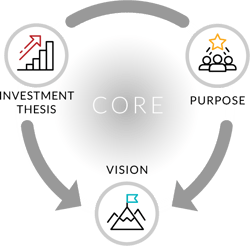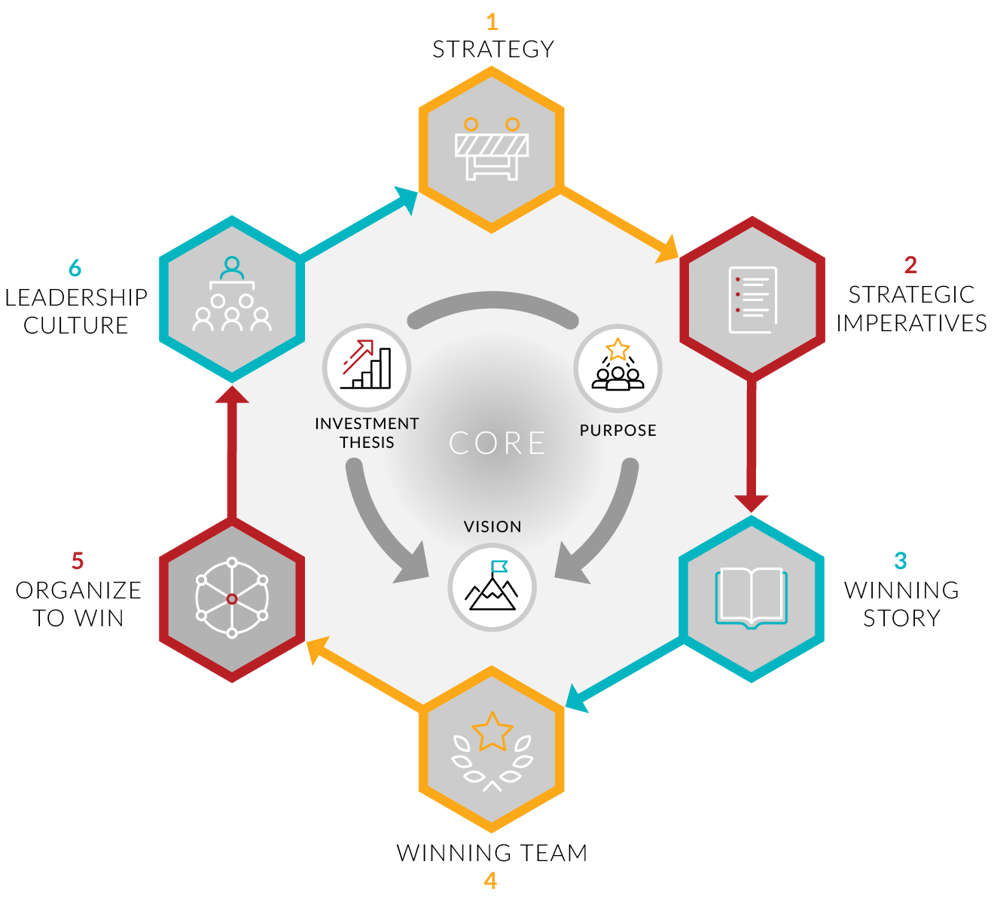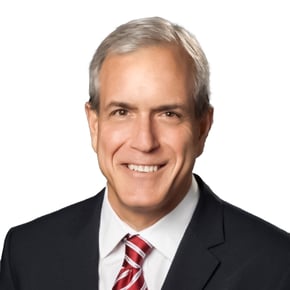No matter how noble your company’s purpose, you should never take its success, much less its survival, for granted.
Just look at the change in components that make up the Dow Jones, the second oldest stock market index in the United States. None of the original 12 industrials are still in it: the last, General Electric, was removed from the index in 2018. Of the companies on the exchange when I was in high school in 1976, only one remains (3M).
The good news is that, in spite of the unprecedented environment in which we are now operating, there is something leaders can do to ensure their company’s success and long-term survival. They can consistently drive performance using a “play to win” framework. I advise CEOs to start at the center of the framework, then work their way through the six critical components.
Align the Core
If you don’t remember anything else from reading this article, remember this. Three things—a relevant investment thesis, a clear purpose, and the operationalization of both in a vision—form a solid foundation on which to build a sustainable business.
 The investment thesis is the ambition and the reason why anyone should give you their money and trust you to provide them with a return. In private equity, this thesis about value creation is usually quite clear and specific; in a public company, it is generally more obtuse.
The investment thesis is the ambition and the reason why anyone should give you their money and trust you to provide them with a return. In private equity, this thesis about value creation is usually quite clear and specific; in a public company, it is generally more obtuse.
The purpose is the reason why the enterprise exists, the difference it will make for stakeholders, above and beyond simply making money for investors and shareholders. UPS, for example, synchronizes global commerce. (Imagine what shape the world would be in if they didn’t exist!)
The vision takes everything you are trying to accomplish in terms of creating value and making a difference in the world and translates it into the operation of the business. Leaders must clearly communicate that vision far and wide so everyone knows what they are responsible for and what they can do to help accomplish the company’s purpose and ambition. The vision at Frito-Lay®, when I was with the company, was to put a bag of tasty, unbroken, affordable chips within arms’ reach of every man, woman and child in America.
People expect you, as a member of the Golden Triangle of CEO, CHRO and CFO, to do the hard work of aligning your company’s investment thesis, purpose and vision. Without that alignment, they know the organization will certainly not stand a chance of even playing to win, let alone winning.
Set Strategy, Tell Your Winning Story
Once the C suite have alignment on the core, they can dive into the first three components of playing to win. In all this work, be thoughtful and realistic. CEOs and CFOs will lead here; CHROs will engage and have a point of view, but won’t necessarily have to be the driving force behind these factors.
 1. Strategy
1. Strategy
Richard Rummelt, professor of business and society at UCLA’s Anderson School of Management, says, “A strategy is a way through a difficulty, an approach to overcoming an obstacle, a response to a challenge…. It is coherent action backed by an argument.”* I love this definition, mainly because it does away with the kind of strategic planning that focuses more on aspiration than on data-driven insights and decisive choices. Strategy is about identifying the critical aspects of the situation, choosing an overall approach, and designing a coordinated set of coherent actions. Success here depends on accurately diagnosing and analyzing the difficulty, obstacle or challenge, and leveraging competitive advantage.
 2. Strategic Imperatives
2. Strategic Imperatives
Three or four strategic imperatives drive the execution of the strategy. Stay away from aspirational “blue sky” thinking here: every imperative must drive outcomes that can be accomplished given existing resources and competencies. Avoid drawing up a dog’s breakfast: the three or four you choose must be pivotal.
When I was at Frito-Lay, change hit, value shifted, and money moved to a new competitor. Annheuser-Busch had entered the salty snacks market and, through a combination of great quality and aggressive pricing, they had been able to seize enough market share to challenge our dominant position. In response, Frito-Lay quickly developed a new strategy, along with the following imperatives, to mobilize the organization and its talent:
- Take back the streets.
- Make quality a reality.
- Be the low-cost producer on a per unit basis.
- Win together.
For more details of the Frito-Lay story, see my article “Results + Integrity: The Foundation of Effective Executive Leadership”.
 3. Winning Story
3. Winning Story
The communication of a winning story, one that is clear, compelling and aligned, must have a regular cadence to it. Every employee, in order to perform at their highest level, must understand what’s working, what’s not, and what they can do to help. With that understanding, they have many more degrees of freedom to take action.
Create a Winning Team
 4. Winning Team
4. Winning Team
No matter how solid your core or how good your strategy and story, if you don’t have the right talent in your CXO executive roles, all will be for naught. By the right talent, I mean people who, at the very least, have already demonstrated their ability to deliver results that are aligned with what you want to accomplish. CHROs take the value levers here in terms of differentiating, developing, and deploying talent to these select roles that contribute significantly to value creation and/or competitive advantage. They must, with their CEO, come up with a decisive view on each individual’s performance, potential, and corresponding opportunities.
While leadership talent is necessary, it alone is not sufficient to drive winning performance. You must also have enough talent in mission critical roles across and down into the organization where significant value is being created or can be lost. When I was CHRO at Macy’s, we decided, after a lot of debate, there were three mission critical roles in the organization, each worthy of their own talent strategies.
- Data scientists
- Customer-facing technologists
- Fulfillment experts.
While it was hard work getting to alignment on this decision, it created a lot of value for the organization. Think about it. Across an enterprise of 150,000 employees in many, many different roles, it should be hard work to understand and then align around specific talent strategies for mission critical roles.
At that time, everyone believed store managers were the most mission critical of all roles. We had our reasons to settle on these three instead. The retail business was beginning to shift online, and that meant store managers would not deliver what we were looking for in terms of competitive advantage. Online business was not yet as profitable as bricks-and-mortar, mainly because of shipping costs. Data scientists, however, could help process and manage the huge amounts of data a complex business generates. They could help us understand what was going on—either from a customer standpoint or an operations perspective—“underneath the hood”. The customer-facing technologists could help us quickly capture site visitors and their real-time feedback. They could advocate for a better customer experience, while ensuring that product and technology decisions were aligned across the company to deliver profitable growth and more delighted customers. And fulfilment experts, in collaboration with our data scientists, could manage inventories very well, optimize delivery systems, and improve our returns significantly. In the end, our decision to focus on these three critical roles proved to be the right one.

The world will continue to change. I don’t know what the future holds for business or society as a whole. But I do know this. You can accomplish things you never imagined were possible using this “play to win” framework. I’ve seen myself the magic that happens when you align a company’s core—its investment thesis, purpose and vision—with a coherent strategy, a few strategic imperatives, a compelling story and then power them up with a winning team, leadership culture, and organization.
Just remember success does not guarantee survival.
* Richard Rummelt, “The Perils of Bad Strategy”, McKinsey Quarterly, June 2011. Accessed January 19, 2022 at https://www.mckinsey.com/business-functions/strategy-and-corporate-finance/our-insights/the-perils-of-bad-strategy.

